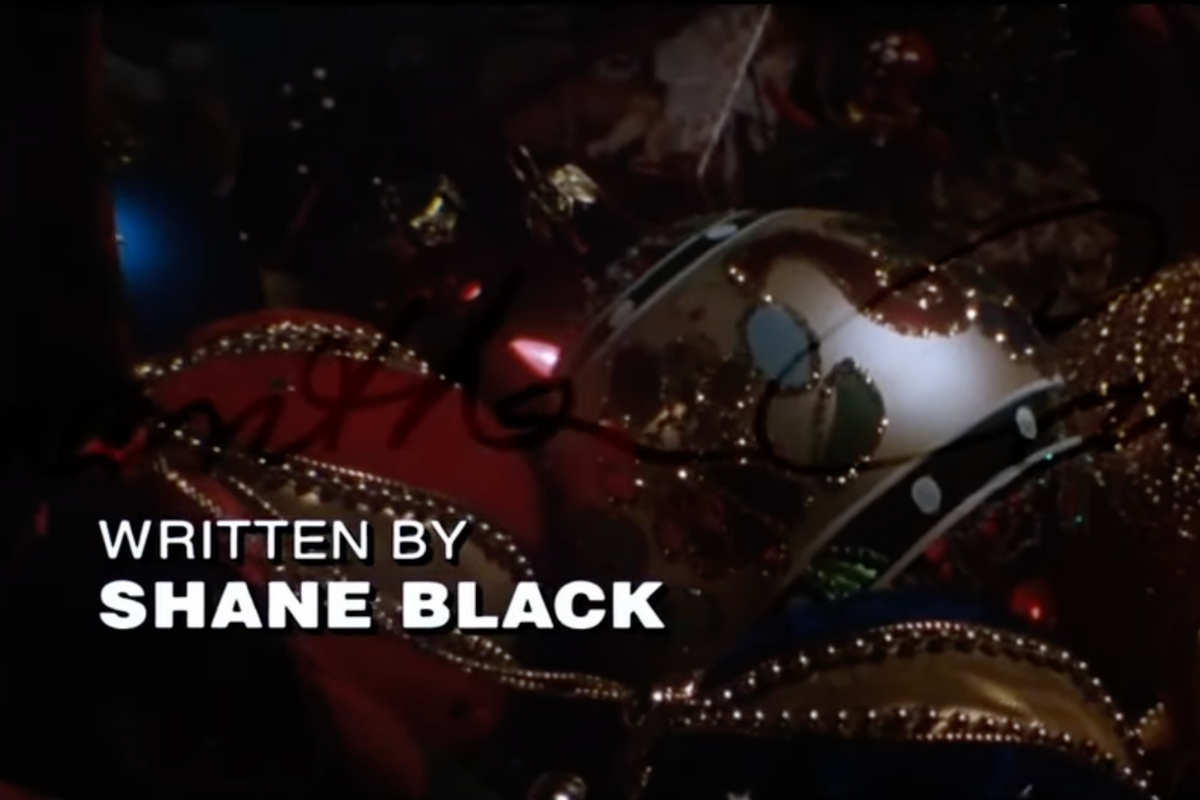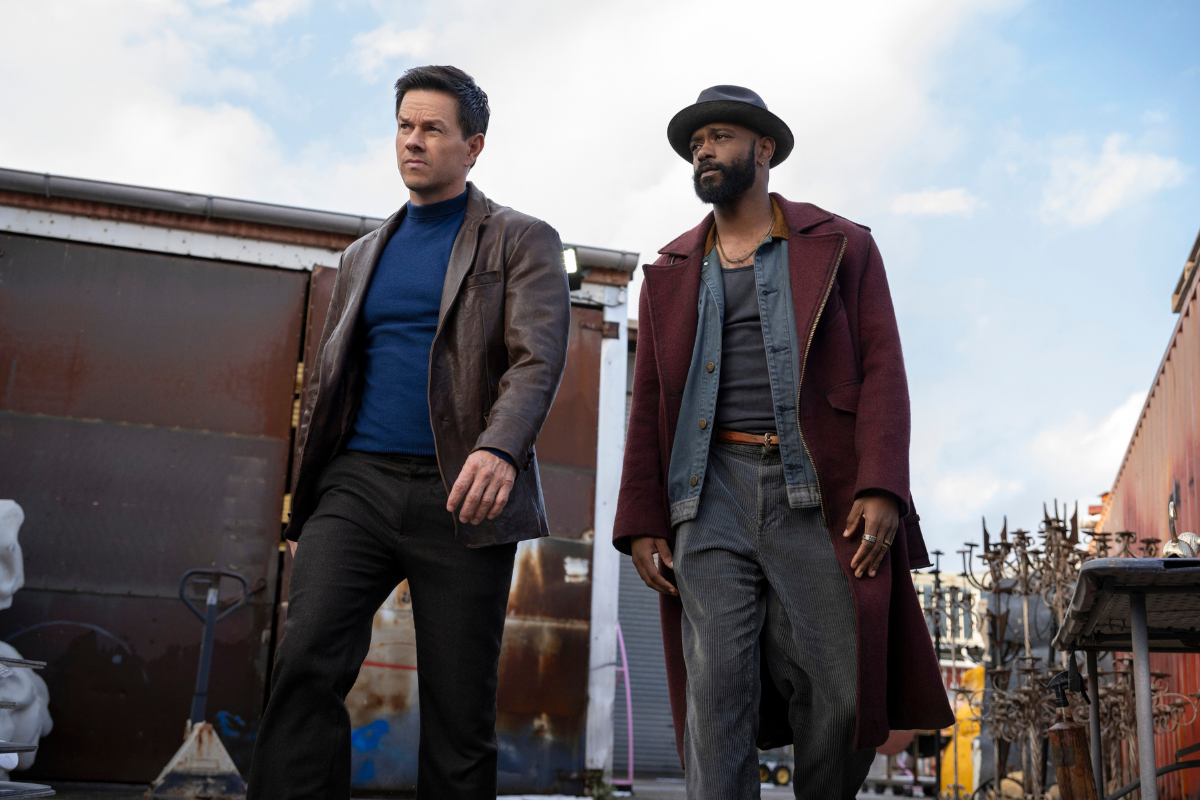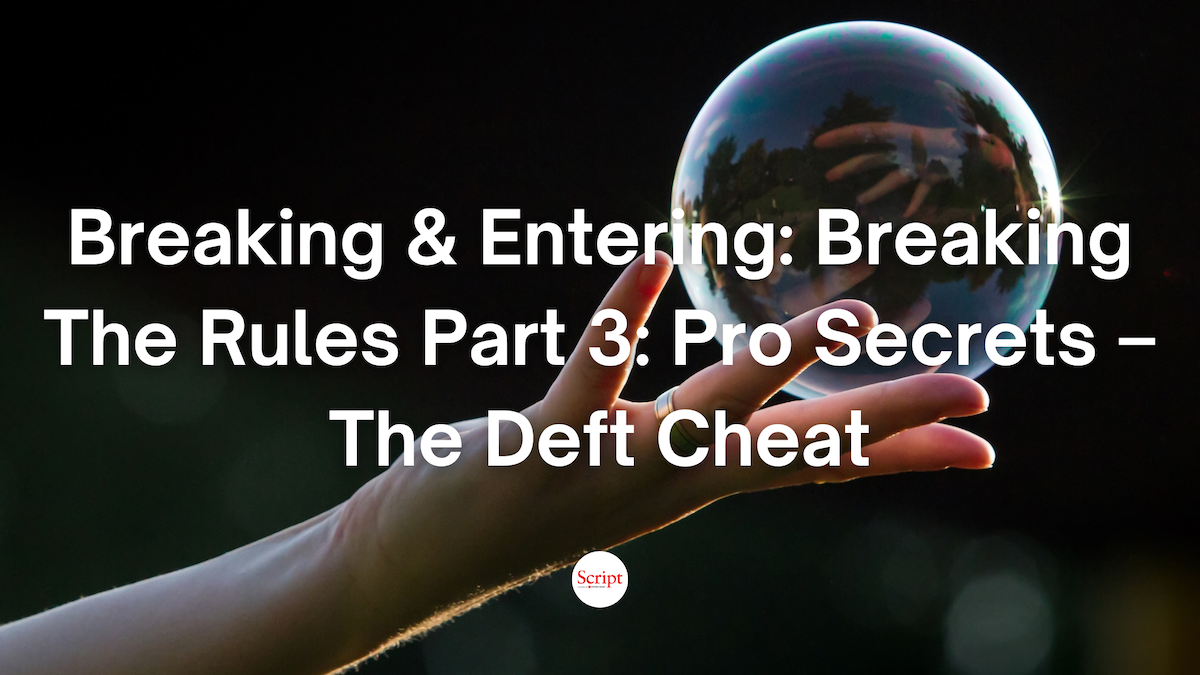Breaking & Entering: Ready to Write The Spectacular Spec? Here’s How to Shoot for The Stars!
The spec market is tough. Discover what writers whose specs launched their careers know. Fresh and fantastic pointers for creating a spec that creates a buzz.
In a profession that requires reading a mountain of scripts, it is surprisingly rare that we come across a screenplay that has a unique voice and vision. One where the writer showcases a distinctive sensibility that is the perfect compliment to the engaging story they’ve chosen to tell. It feels like a bolt of lightning, a quadruple shot of espresso, or glimpsing a shooting star. Jaded, world-weary, and eye-strained execs are elated. Even if this isn’t a movie we’re going to make for a practical reason, we definitely want to know the writer.
Your voice will not appeal to 100% of the people. No one likes everything, but this means you shouldn’t be discouraged if you don’t find fans right off the bat. When you discover champions, those people will be your best boosters. They will talk about it. They will recommend you to managers and agents who will be a good match. When Zach Helm’s spec, Stranger Than Fiction went out, everyone in the industry was asking each other if they’d read it yet. Beyond the clever conceit, this was a fresh, innovative voice in comedy, and offered sharp social commentary. The script was getting passed around, and this was in Ye Olden Days when scripts were printed on paper! Buzz generates buzz.
This is how the original Black List began. Franklin Leonard, frustrated by bad scripts submitted by reps, asked fellow execs to list the best scripts they had read that year. While people shared this scoop within a small circle of friends and colleagues, Franklin scaled this up to create an annual list of the 100 best, unproduced screenplays of the year. Many have gone on to be produced and win awards. Franklin even calls his TEDx talk, “How I accidentally changed the way movies get made.” It’s worth watching.
So what is the magical quality? It’s different for everyone, so I can’t answer that for you. What I can tell you is where to look.
Rare, Elegant, and Valuable
I’ve used the metaphor of the oyster, the grain of sand, and the pearl when talking about writing true stories and in an unconventional wisdom column, “Write What You Know is Wrong.” My goal was to convince writers working in this genre to find the essence, that which illuminates a lifetime, perhaps the motivation that drives them, and not include everything, just because it really happened. It’s always a high-wire act to balance the facts with the needs of a dramatic narrative.
But actually, the metaphor may be far more apt here. Pearls have been sought after for two thousand years. Prized for their luster and iridescence, they are considered rare, elegant, and valuable. The magic of pearls is that the poor oyster gets an irritating grain of sand stuck inside it. Think of a pebble stuck in your shoe, except to the oyster this is akin to a boulder landing in their bedroom. It can huff and puff, but it cannot get rid of the grain of sand. So what does the inventive oyster do? It begins to cover the sand in layers of nacre, otherwise known as mother-of-pearl, that shiny surface you can see on the inside lining of the shells. It lays down coats after coats, smoothing the surface. It eventually forms a pearl.
Natural pearls are rare and valuable. They are the only jewels in existence created by a living creature. Some oysters will produce only two or three good pearls over their lifetime. If you can say as much as a screenwriter, creating two or three successful original films or series, you will have had a very good career.
Alrighty, end of marine biology lesson; back to screenwriting.
No one else has your grain of sand! Your life experiences shape how you see the world. Your background and the stories that have profoundly affected you are the key to discovering your grain of sand. Ultimately, it should reflect your deepest beliefs about life and what you think is important.
Now your job is to identify your grain of sand!
Like pearls, which can take months or years to develop, it may take some time to locate your grain of sand and begin the work of, layer upon layer, developing your voice while generating story ideas where it will shine. Read a lot, write a lot, and watch a lot of stories as part of this process.
As with oysters, the odds of producing a jewel are not in your favor. Only about one in 10,000 wild oysters produce a pearl, and even then, not all of them are the size, shape, and color that makes them desirable to the jewelry industry. Am I calling you an oyster? Well, if the mollusk fits…
OK, I lied. One more fascinating pearl fact was passed down to me by my mother along with several very special pieces of jewelry. When you wear pearls, they warm to your body temperature. Should you Google this, I have no idea what results you will find. But should you be lucky enough to wear pearl jewelry, you know I speak the truth. And why did I shove this in here? Because the key to producing the pearl – I mean spec script – that stands out like a precious jewel, is that it will match the desires and meet the hunger of people in the industry for discovering a new voice and vision.
Just One Pearl to Launch Your Career
That spectacular spec that knocks people’s socks off, gets them talking and makes them want to know you. Many writers considered their pearl of a spec to be a last-ditch effort, while others were newer to screenwriting and hit it out of the ballpark. Every writer’s process was different, but all involved a lot of deep thinking, discovering their characters, questioning their choices, and often an incredible amount of rewriting.
Richard LaGravenese on The Fisher King: “I didn’t find the story for a while – it took over a year and a half while also putting it down for several months at a time and not reading it at all because I didn’t know what I was doing since it was the first script I wrote by myself.” Read more here.
Michael Arndt on Little Miss Sunshine: “In 1998, I had written a bunch of screenplays and they all had this edgy, downbeat, unhappy ending. I didn’t have an agent, I didn’t have a producer, I didn’t have anything basically. So I’m sitting down writing screenplay number six and I was like, ‘OK, maybe I should try doing something different.’ My brilliant insight was that people actually prefer being happy to being unhappy, so maybe I should try writing happy endings. And I thought, ‘OK, not only am I going to write a happy ending, I’m going to write the happiest ending of all time. I’m going to write the happiest fucking ending possible.’ My goal was to drive the audience insane with happiness. And I was thinking about what constitutes a happy ending.” Read more here.
Callie Khouri on Thelma & Louise: “I felt I had not found my true path. And then a series of events occurred that led me to the point where I didn’t have anything to lose if I wrote a screenplay… I kept praying for an answer, contemplating and meditating, asking for help so I could be put on my proper path. And that’s when I got this idea: ‘Two women go on a crime spree.’ As soon as I had the idea I felt this strange sense of euphoria. The more I thought about it, the more excited I became. I mean, what would make two seemingly normal women go on a crime spree? Why would they do that? Why would I go on a crime spree?” Read more here.
Jeff Arch on Sleepless in Seattle: “The main thing was the two people weren't going to meet. The next thing that came was, 'What if they don't meet at all until the end, and they meet at the Empire State Building at sunset on Valentine's Day?' Everything after that was academic: will this get them to the Empire State Building on page 120? Really, I got the idea out of frustration. Thank God a little breakthrough happened. And the whole thing fell into my lap one night. It sounds like a public relations story, but it's true. I looked up through a skylight at a sky full of stars, and I said, 'For every star in the sky there's a good idea.' And the ideas just came to me. That's really what happened. And it's still one of the most amazing things that ever happened in my life." Read more here.
None of these spec scripts were what the industry would consider high-concept ideas. They don’t lend themselves to a logline, and would never have been set up as a pitch. These execution dependent ideas derived their deliciousness from the hundreds of thousands of decisions that go into a screenplay. They delivered, with an inventive concept, unique and dimensional characters, and a meaningful message. Coupled with a noteworthy voice, they found passionate champions, ultimately garnered both critical accolades and box office success, and launched their careers. Each brought a little bit of magic.
One Singular Sensation
Aspiring writers sometimes worry about having a unique story. Often, they keep adding elements until it overwhelms the script. A movie is a simple story complexly told.
I could give the exact same story idea to ten professional writers. And I would get back ten extremely different scripts.
Because working writers know two things:
- They have cultivated the ability to sniff out intriguing ideas. It might be set off by something small, but they listen to that inner voice that whispers, “Hey, there might be something here…” They say, “What if?” and work and rework, digging deeper, adding layers, until every piece is perfectly in place.
- They’ve located their grain of sand. They understand their personal thematic, what they want to say that matters to them. It shapes their voice and elevates their execution.
Too often we find scripts that are, as the musical and film, A Chorus Line, lamented, “Dance: Ten, Looks: Three.” Meaning the idea and the execution are not on the same level. You have to aim for perfect scores.
Aside from the things you know you should be doing as a writer who aspires to be paid to write, here’s my single best and most fun piece of advice on how to get there.
For You Blue
Exciting stories often combine something familiar with something new, which makes them extra appealing to our story-loving brains. It reminds me of the old English poem – so old it’s spelled “olde” – about what a bride should wear on her wedding day to bring good luck and a happy marriage: “Something old, something new, something borrowed, something blue.” This adage also has something to offer you in the search for and development of ideas.
Something Old
An element of the story, whether a character or relationship dynamic, the storyline, or a familiar trope, that has been around before. It’s familiar to us, which is appealing because we know we will enjoy it.
Something New
There is a special kind of thrill when a story takes a familiar element and spins it in a new way, whether flipping it on its head, changing the genre, or setting it in a new era. We’re conditioned to expect one thing, but you, clever writer that you are, know that, and can both deliver on our expectations and subvert them.
Something Borrowed
Borrowing something from well-loved tales strengthens stories. Those classic paradigms are used time and again because they work. The great writers who came before you left you a treasure map with their writing. Use it to find your own pot of gold.
Something Blue
You might be wondering how I will manage to pull off this one, but it’s actually the best of all! It challenges the bride to come up with something meaningful to her within a constraint – it has to be blue. That imposes a limitation – and limitations are good. They force us to be creative, making the end result even better.
Of course, grooms can get in on this too!
I Guess That’s Why They Call It The Blues
The grain of sand leads to your unique theme or personal thematic. Theme makes stories memorable. No matter genre, budget, or stars, theme gets us because we get theme. We begin to learn it from children’s stories and fairy tales.
When talking with successful writers, I’m fascinated by the themes that drive their work, and often found in the scripts that catapulted their careers. If I can ask only one question, “What themes speak to you, time and again, in your writing?” will always be it.
Tab Murphy gave an answer that I think articulates the grain of sand-slash-personal thematic perfectly:
When you get a chance to do what you love to do as a writer, especially in screenwriting, where you can come up with any story and write it – obviously the business is changing – but when I broke in in 1983, it was wide open. You really could dream up a story and write anything you were passionate about. That’s how I approached it.
When you do that, you tend to draw from “what made you.” Whether it’s things you were drawn to as a child – what molded you. Things you watched as a child, what stories you read at a young age, what you did with your free time.
All of those things combined, at least for me, to create a theme that I find runs through a lot of my work, which is man or woman’s place in nature, or man or woman against nature. Mainly it’s our relationship with nature. I’ve always explored that theme. It’s apparent in Last of The Dogmen. It’s apparent in Gorillas in the Mist.
I grew up camping and loving the outdoors and spending a lot of time outdoors. I love wilderness. I love wild places. I love the idea that there are places in the United States where you can still hear a wild wolf howl, or where grizzly bears roam. This informed a lot of what I chose to write early in my career, and what I ended up writing later in my career. It still runs through my work today.
Forty years later, I’m still writing about the same themes. Because they’re important to me. And because they’re relevant to the world we’re living in today. Our relationship with nature. You can connect that to climate change. You can connect that to indigenous people that are disappearing, languages that are disappearing. What’s our relationship to that?
Tab Murphy, Gorillas in the Mist, Last of The Dogmen, Hunchback of Notre Dame, Tarzan, Atlantis: The Lost Empire, Brother Bear
You can find more of these responses in my blog, "Screenwriters Speak: Themes that Fascinate A-List Writers." Check back, as there are always more to come from my Screenwriting Elevated Seminar Guest Speakers.
Find the message that you as a writer are most moved by, that speaks to you on a deep level, that draws on what you believe is important in life, and you will move an audience.
If you’re in search of your grain of sand, check out “Personal Thematic: Creating Stories That Move Us.” It includes a fun exercise that helps writers uncover the message that speaks to them – even if they didn’t realize it.
Blue Suede Shoes
Specificity is a sign of strong writing. No decisions should be random. Specificity shows focus and adds depth. It proves you understand your characters, their world, and how they all work to support what the story is really about.
Your characters’ voices should be specific to them. Once you’ve introduced them, we shouldn’t have to read their names above the dialogue because their words reflect their character. No other character would have said it, or certainly not in the same way.
While great dialogue is important, description has more impact. “Actions speak louder than words.” Or to put it more eloquently, as he always does, the extraordinarily prolific screenwriter Terry Rossio, who with his oft-time partner, Ted Elliott, have a string of box office hits and franchises, offers this nugget of wisdom courtesy of their handy dandy website for screenwriters, Wordplayer:
Visual, Aural, Verbal – in that order. The expression of someone who has just been shot is best; the sound of the bullet slamming into him is second best; the person saying “I’ve been shot” is only third best.
Terry Rossio, Godzilla vs. Kong, Pirates of the Caribbean, Aladdin, Shrek
Subtext illuminates characters’ inner thoughts and feelings. Conveyed through action and reaction, it includes expressions, gestures, body language, and how they interact with their surroundings and with other characters. Again, no two characters should be the same. It is the secret to engaging readers with your words by activating their own emotions.
You can use less words and have more richness and significance: “Sad, he slowly walked out the door,” versus “He shuffled out.” It’s visual and visceral. That’s subtext in a nutshell.
Subtext elevates your writing. We’re no longer just reading words on a page; it has become experiential. We aren’t being told about emotions; we feel them.
Activating our emotions bonds us to your characters. We become invested in their outcome. And, in the principle that is fundamental to all storytelling, it makes us want to know, “What happens next?”
This is what we humans crave in story. It’s what keeps gets us up off the couch and into movie theatres, keeps us up late watching one more episode of a series, or reading one more chapter of a novel. Even if we know the ending!
No one went into Titanic wondering if the ship was going to sink. Not to mention the films and shows that we watch time and again and still enjoy.
As a teacher, a consultant, and a columnist, I’m always looking for new ways to explain concepts so that absolutely everyone has an "ah-ha" moment. Until then, I’ll keep creating metaphors. It wasn’t until I started this column that I realized that the oyster and the pearl were meant to be here. And as for Something Blue, I’ve no notion of where that came from. It’s as if it just fell from the stars.
Keep digging deep and keep looking up!
Barri Evins draws on decades of industry experience to give writers practical advice on elevating their craft and advancing their career. Her next SCREENWRITING ELEVATED online seminar with 7 monthly sessions plus mentorship will be announced in 2025. Breaking & Entering is peppered with real life anecdotes – good, bad, and hilarious – as stories are the greatest teacher. A working film producer and longtime industry executive, culminating in President of Production for Debra Hill, Barri developed, packaged, and sold projects to Warners, Universal, Disney, Nickelodeon, New Line, and HBO. Known for her keen eye for up and coming talent and spotting engaging ideas that became successful stories, Barri also worked extensively with A-List writers and directors. As a writer, she co-wrote a treatment sold in a preemptive six-figure deal to Warners, and a Fox Family project. As a teacher and consultant, Barri enables writers to achieve their vision for their stories and succeed in getting industry attention through innovative seminars, interactive consultations, and empowering mentorship. Follow her on Facebook or join her newsletter. Explore her Big Ideas website, to find out about consultations and seminars. And check out her blog, which includes the wit and wisdom of her pal, Dr. Paige Turner. See Barri in action on YouTube. Instagram: @bigbigideas X: @bigbigideas







